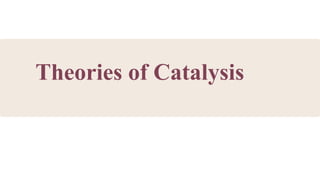
Theories of Catalysis. Theory of intermediate compound foramtion and Adsorption theory
- 2. For a chemical reaction to occur, the reactants are to be activated to form the activated complex. The energy required for the reactants to reach the activated complex is called the activation energy. The activation energy can be decreased by increasing the reaction temperature.
- 3. In the presence of a catalyst, the reactants are activated at reduced temperatures in otherwords, the activation energy is lowered. The catalyst adsorbs the reactants activates them by weakening the bonds and allows them to react to form the products.
- 4. As activation energy is lowered in presence of a catalyst, more molecules take part in the reaction and hence the rate of the reaction increases.
- 5. The action of catalysis in chemical reactions is explained mainly by two important theories. They are (i) the intermediate compound formation theory (ii) the adsorption theory.
- 6. 1. The intermediate compound formation theory According to this theory, a catalyst must chemically combine with one or more reactants to form an unstable intermediate product. It decomposes or combine later with other reactant to form the product and the catalyst is regenerated. A+ [catalyst] [intermediate] [intermediate] + B Product + [catalyst]
- 7. Consider the reactions: A+B → AB (i) C is the catalyst The reaction proceeds by following steps:- A+C → AC (unstable intermediate) (ii) AC+B → AB+C (iii) 1. The intermediate compound formation theory C
- 8. AC+B → AB+C (3) Activation energies for the reactions (2) and (3) are lowered compared to that of (1). Hence the formation and decomposition of the intermediate accelerate the rate of the reaction.
- 9. The catalytic oxidation of SO2 to SO3 in lead chamber process 2 NO + O2 → 2NO2 NO2 + SO2 → SO3 + NO Example 1 Catalyst Intermediate compound Catalyst Product
- 10. Example 2 Thermal decomposition of KClO3 in presence of MnO2 proceeds as follows. 2KClO3 → 2KCl+3O2 Steps in the reaction 2KClO3 +6MnO2 → 6MnO3 +2KCl It is an intermediate. 6MnO3 → 6MnO2 +3O2
- 11. It is an intermediate. Formation of water due to the reaction of H2 and O2 in the presence of Cu proceeds as follows: H2+½O2 → H2O Cu+ 1/2 O2 → Cu2O Cu2O+H2 → H2O + 2Cu Example 3:
- 12. This theory describes (i) the specificity of a catalyst and (ii) the increase in the rate of the reaction with increase in the concentration of a catalyst.
- 13. a. The intermediate compound theory fails to explain the action of catalytic poison and activators (promoters). b. This theory is unable to explain the mechanism of heterogeneous catalyzed reactions Limitations
- 15. Langmuir explained the action of catalyst in heterogeneous catalyzed reactions based on adsorption. The reactant molecules are adsorbed on the catalyst surfaces, so this can also be called as contact catalysis. According to this theory, the reactants are adsorbed on the catalyst surface to form an activated complex which subsequently decomposes and gives the product.
- 16. Adsorption theory explains the mechanism of reaction between two gases catalyzed by heterogeneous catalysis/ contant catalysis. Reactants adhere to the surface of a catalyst through adsorption, which enhances the rate of a chemical reaction. This theory was developed to explain the mechanism of heterogeneous catalysis, where the catalyst is in a different phase (usually solid) than the reactants (usually gases or liquids). 2. Adsorption theory
- 17. Here are some key points of the adsorption theory of catalysis: 1. Adsorption of reactant molecule Reactant molecules adsorb (stick) to the surface of the catalyst. This adsorption can be physical (van der Waals forces) or chemical (formation of chemical bonds). 2. Formation of activated complex the particles of reactant adjacent to one another join to form an intermediate complex (A-B). The activated complex is unstable, it has fleeting existence.
- 18. Here are some key points of the adsorption theory of catalysis: 3. Decomposition of the activated complex The activated complex breaks to form product C and D. the separated particles of the product hold to the catalyst surface by partial chemical bonds. 4. Desorption of product The particles of product areca desorbed or released from the surface. They are stable and can lead an independent existance.
- 19. The surface of a catalyst is not smooth. It bears steps, cracks and corners. Hence the atoms on such locations of the surface are co-ordinatively unsaturated. So, they have much residual force of attraction. Such sites are called active centers. The presence of such active centers increases the rate of reaction by adsorbing and activating the reactants. Active centers